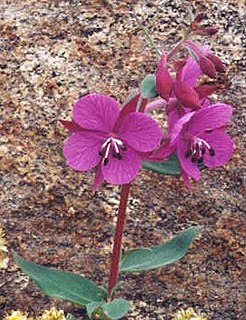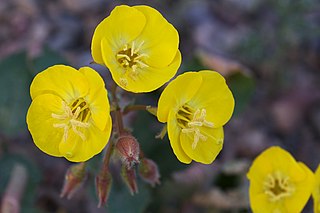
Clover or trefoil are common names for plants of the genus Trifolium, consisting of about 300 species of flowering plants in the legume or pea family Fabaceae. The genus has a cosmopolitan distribution with highest diversity in the temperate Northern Hemisphere, but many species also occur in South America and Africa, including at high altitudes on mountains in the tropics. They are small annual, biennial, or short-lived perennial herbaceous plants. Clover can be evergreen. The leaves are trifoliate, cinquefoil, or septfoil), with stipules adnate to the leaf-stalk, and heads or dense spikes of small red, purple, white, or yellow flowers; the small, few-seeded pods are enclosed in the calyx. Other closely related genera often called clovers include Melilotus and Medicago.

Phlox is a genus of 67 species of perennial and annual plants in the family Polemoniaceae. They are found mostly in North America in diverse habitats from alpine tundra to open woodland and prairie. Some flower in spring, others in summer and fall. Flowers may be pale blue, violet, pink, bright red, or white. Many are fragrant. It attracts hummingbirds and butterflies.

Mirabilis is a genus of plants in the family Nyctaginaceae known as the four-o'clocks or umbrellaworts. The best known species may be Mirabilis jalapa, the plant most commonly called four o'clock.

Helianthus or sunflower is a genus of plants comprising about 70 species. Except for three species in South America, all Helianthus species are native to North America. The common name, "sunflower", typically refers to the popular annual species Helianthus annuus, or the common sunflower, whose round flower heads in combination with the ligules look like the sun. This and other species, notably Jerusalem artichoke, are cultivated in temperate regions and some tropical regions as food crops for humans, cattle, and poultry, and as ornamental plants.

Atriplex is a plant genus of 250–300 species, known by the common names of saltbush and orache. It belongs to the subfamily Chenopodioideae of the family Chenopodiaceae. The genus is quite variable and widely distributed. It includes many desert and seashore plants and halophytes, as well as plants of moist environments. The generic name originated in Latin and was applied by Pliny the Elder to the edible oraches. The name saltbush derives from the fact that the plants retain salt in their leaves; they are able to grow in areas affected by soil salination.

Epilobium is a genus of flowering plants in the family Onagraceae, containing about 197 species. The genus has a worldwide distribution. It is most prevalent in the subarctic, temperate and subantarctic regions, whereas in the subtropics and tropics Epilobium species are restricted to the cool montane biomes, such as the New Guinea Highlands.

Ludwigia is a genus of about 82 species of aquatic plants with a cosmopolitan but mainly tropical distribution.

Camissonia, sometimes commonly known as sun cup or sundrop, is a genus of annual and perennial plants in the evening primrose family Onagraceae. A total of 12 species are known, nearly all from western North America, especially in the California Floristic Province, but also one from South America. Previous circumscriptions of the genus had recognized up to 62 species before it was split among other closely related genera.

Claytonia is a genus of flowering plants native to North America, Central America, and Asia. The genus was formerly included in Portulacaceae but is now classified in the family Montiaceae, primarily native to the mountain chains of Asia and North America, with a couple of species extending south to Guatemala in Central America, and northwest to Kazakhstan, Mongolia, and Russia in eastern Asia.
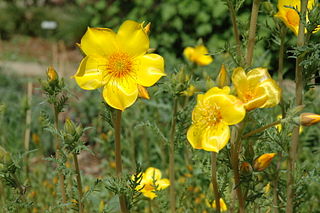
Mentzelia is a genus of about 60-70 species of flowering plants in the family Loasaceae, native to the Americas. The genus comprises annual, biennial, and perennial herbaceous plants and a few shrubs.

Dalea is a genus of flowering plants in the legume family, Fabaceae. Members of the genus are commonly known as prairie clover or indigo bush. Its name honors English apothecary Samuel Dale (1659–1739). They are native to the New World, where they are distributed from Canada to Argentina. Nearly half of the known species are endemic to Mexico. Two species of Dalea have been considered for rangeland restoration.
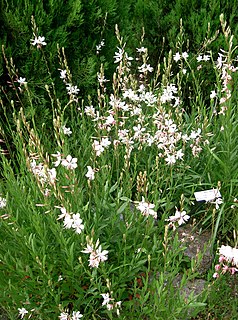
Gaura is a genus of flowering plants in the family Onagraceae, native to North America. The genus includes many species known commonly as beeblossoms. Recent genetic research has shown that the genus is paraphyletic unless the monotypic genus Stenosiphon is included within Gaura, increasing the number of species in the genus to 22.

Perityle is a genus of flowering plants in the daisy family. They are known generally as rock daisies.
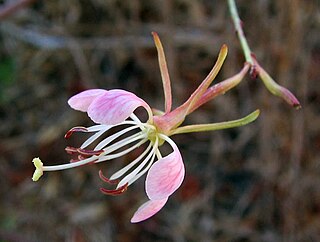
Gaura sinuata is a species of flowering plant in the evening primrose family known by the common names wavyleaf beeblossom and Red River gaura. In 2007 the species, along with the genus Gaura was reclassified in the genus Oenothera. This species then becomes O. sinuosa in Oenothera Section Gaura.

Lipochaeta, common name nehe, is a genus of flowering plants in the daisy family, Asteraceae that is endemic to Hawaii.

Camissoniopsis is a plant genus in the evening primrose family (Onagraceae).

Lopezia is a genus of plants of the family Onagraceae, largely restricted to Mexico.
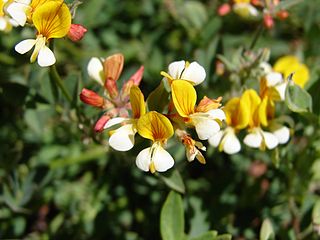
Hosackia is a genus of flowering plants in the family Fabaceae (legumes). It is native to western North America, from British Columbia in Canada to Mexico.

